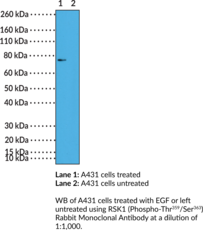Cayman
Showing 38251–38400 of 45550 results
-
Roxithromycin is a semi-synthetic macrolide antibiotic in which the erythronolide A lactone ring has been altered to prevent inactivation in the gastric milieu.{31054,22680} It is active against Gram-positive and Gram-negative cocci, Gram-positive bacilli, and some Gram-negative bacilli without significantly affecting the fecal flora.{31054} Roxithromycin is also effective in eradicating H. pylori.{18258}
Brand:CaymanSKU:-Available on backorder
RP 001 is a potent sphingosine-1-phosphate receptor 1 (S1P1) agonist (EC50 = 9 pM).{27096} It is competitive with W146 (Item No. 10009109), a selective S1P1 antagonist, and induces internalization and polyubiquitination of S1P1 in a dose-dependent manner. RP 001 induces dose-dependent lymphopenia in mice (EC50 = 0.03 mg/kg). It reduces S1P1-EGFP expression ex vivo on lymphocytes in the isolated lymph node of Edg1eGFP/eGFP mice but has no effect in vivo. RP 001 also completely inhibits M. stadtmanae (MSS) rechallenge-induced enlargement of B cell-rich tertiary lymphoid tissues (TLTs) and reduces neutrophil accumulation in the airways of a mouse model of experimental hypersensitivity pneumonitis.{40737}
Brand:CaymanSKU:-Out of stock
RP 001 is a potent sphingosine-1-phosphate receptor 1 (S1P1) agonist (EC50 = 9 pM).{27096} It is competitive with W146 (Item No. 10009109), a selective S1P1 antagonist, and induces internalization and polyubiquitination of S1P1 in a dose-dependent manner. RP 001 induces dose-dependent lymphopenia in mice (EC50 = 0.03 mg/kg). It reduces S1P1-EGFP expression ex vivo on lymphocytes in the isolated lymph node of Edg1eGFP/eGFP mice but has no effect in vivo. RP 001 also completely inhibits M. stadtmanae (MSS) rechallenge-induced enlargement of B cell-rich tertiary lymphoid tissues (TLTs) and reduces neutrophil accumulation in the airways of a mouse model of experimental hypersensitivity pneumonitis.{40737}
Brand:CaymanSKU:-Out of stock
RP 001 is a potent sphingosine-1-phosphate receptor 1 (S1P1) agonist (EC50 = 9 pM).{27096} It is competitive with W146 (Item No. 10009109), a selective S1P1 antagonist, and induces internalization and polyubiquitination of S1P1 in a dose-dependent manner. RP 001 induces dose-dependent lymphopenia in mice (EC50 = 0.03 mg/kg). It reduces S1P1-EGFP expression ex vivo on lymphocytes in the isolated lymph node of Edg1eGFP/eGFP mice but has no effect in vivo. RP 001 also completely inhibits M. stadtmanae (MSS) rechallenge-induced enlargement of B cell-rich tertiary lymphoid tissues (TLTs) and reduces neutrophil accumulation in the airways of a mouse model of experimental hypersensitivity pneumonitis.{40737}
Brand:CaymanSKU:-Out of stock
RP 001 is a potent sphingosine-1-phosphate receptor 1 (S1P1) agonist (EC50 = 9 pM).{27096} It is competitive with W146 (Item No. 10009109), a selective S1P1 antagonist, and induces internalization and polyubiquitination of S1P1 in a dose-dependent manner. RP 001 induces dose-dependent lymphopenia in mice (EC50 = 0.03 mg/kg). It reduces S1P1-EGFP expression ex vivo on lymphocytes in the isolated lymph node of Edg1eGFP/eGFP mice but has no effect in vivo. RP 001 also completely inhibits M. stadtmanae (MSS) rechallenge-induced enlargement of B cell-rich tertiary lymphoid tissues (TLTs) and reduces neutrophil accumulation in the airways of a mouse model of experimental hypersensitivity pneumonitis.{40737}
Brand:CaymanSKU:-Out of stock
Rp-8-bromo-Cyclic AMPS (Rp-8-bromo-cAMPS) is a cell-permeable cAMP analog that combines an exocyclic sulfur substitution in the equatorial position of the cyclophosphate ring with a bromine substitution in the adenine base of cAMP.{26215,28143} It acts as an antagonist of cAMP-dependent protein kinases (PKAs) and is resistant to hydrolysis by cyclic nucleotide phosphodiesterases. Rp-8-bromo-cAMPS more effectively antagonizes cAMP-dependent activation of purified PKA type I from rabbit muscle than PKA type II from bovine heart.{28143}
Brand:CaymanSKU:21584 -Out of stock
Rp-8-bromo-Cyclic AMPS (Rp-8-bromo-cAMPS) is a cell-permeable cAMP analog that combines an exocyclic sulfur substitution in the equatorial position of the cyclophosphate ring with a bromine substitution in the adenine base of cAMP.{26215,28143} It acts as an antagonist of cAMP-dependent protein kinases (PKAs) and is resistant to hydrolysis by cyclic nucleotide phosphodiesterases. Rp-8-bromo-cAMPS more effectively antagonizes cAMP-dependent activation of purified PKA type I from rabbit muscle than PKA type II from bovine heart.{28143}
Brand:CaymanSKU:21584 -Out of stock
Rp-8-bromo-Cyclic AMPS (Rp-8-bromo-cAMPS) is a cell-permeable cAMP analog that combines an exocyclic sulfur substitution in the equatorial position of the cyclophosphate ring with a bromine substitution in the adenine base of cAMP.{26215,28143} It acts as an antagonist of cAMP-dependent protein kinases (PKAs) and is resistant to hydrolysis by cyclic nucleotide phosphodiesterases. Rp-8-bromo-cAMPS more effectively antagonizes cAMP-dependent activation of purified PKA type I from rabbit muscle than PKA type II from bovine heart.{28143}
Brand:CaymanSKU:21584 -Out of stock
8-bromo-cGMP (Item No. 15992) is a cell-permeable analog of cGMP that exhibits resistance to hydrolysis by phosphodiesterases. It preferentially activates cGMP-dependent protein kinase (cGK).{25938} Rp-8-bromo-Cyclic GMPS (Rp-8-bromo-cGMPS) is a cell-permeable cGMP analog that adds an equatorial exocyclic (Rp) sulfur substitution in the axial position of the cyclophosphate ring of 8-bromo-cGMP. Like 8-bromo-cGMP, Rp-8-bromo-cGMPS is resistant to hydrolysis by phosphodiesterases. This Rp isomer binds cGK without activating it, resulting in competitive inhibition.{29700,29701} At 10 µM, it blocks the relaxation of rat tail arteries induced by the nitric oxide donor SIN-1 (Item No. 82220).{29702}
Brand:CaymanSKU:-Available on backorder
8-bromo-cGMP (Item No. 15992) is a cell-permeable analog of cGMP that exhibits resistance to hydrolysis by phosphodiesterases. It preferentially activates cGMP-dependent protein kinase (cGK).{25938} Rp-8-bromo-Cyclic GMPS (Rp-8-bromo-cGMPS) is a cell-permeable cGMP analog that adds an equatorial exocyclic (Rp) sulfur substitution in the axial position of the cyclophosphate ring of 8-bromo-cGMP. Like 8-bromo-cGMP, Rp-8-bromo-cGMPS is resistant to hydrolysis by phosphodiesterases. This Rp isomer binds cGK without activating it, resulting in competitive inhibition.{29700,29701} At 10 µM, it blocks the relaxation of rat tail arteries induced by the nitric oxide donor SIN-1 (Item No. 82220).{29702}
Brand:CaymanSKU:-Available on backorder
Rp-8-bromo-PET-Cyclic GMPS (Rp-8-bromo-PET-cGMPS) is an analog of cyclic GMP (cGMP). It is a cell permeable, competitive, and reversible inhibitor of cGMP-dependent protein kinases (cGKs) that blocks activation of cGKI and cGKII by cGMP (Kis = 35 and 30 nM).{29701,30362} It less potently inhibits protein kinase A (Ki = 11 µM) and cGMP-induced activation of cyclic nucleotide-gated channels (IC50 = 25 µM).{29701,30363} In the absence of cGMP stimulation, Rp-8-bromo-PET-cGMPS can act as a partial agonist of cGKI (Ki = 1 µM).{30362} Rp-8-bromo-PET-cGMPS is resistant to hydrolysis by phosphodiesterase 11.{24263}
Brand:CaymanSKU:-Available on backorder
Rp-8-bromo-PET-Cyclic GMPS (Rp-8-bromo-PET-cGMPS) is an analog of cyclic GMP (cGMP). It is a cell permeable, competitive, and reversible inhibitor of cGMP-dependent protein kinases (cGKs) that blocks activation of cGKI and cGKII by cGMP (Kis = 35 and 30 nM).{29701,30362} It less potently inhibits protein kinase A (Ki = 11 µM) and cGMP-induced activation of cyclic nucleotide-gated channels (IC50 = 25 µM).{29701,30363} In the absence of cGMP stimulation, Rp-8-bromo-PET-cGMPS can act as a partial agonist of cGKI (Ki = 1 µM).{30362} Rp-8-bromo-PET-cGMPS is resistant to hydrolysis by phosphodiesterase 11.{24263}
Brand:CaymanSKU:-Available on backorder
Rp-8-CPT-cAMP is a structural combination of the lipophilic and non-hydrolyzable cAMP analogs, 8-CPT-cyclic AMP (Item No. 12011) and Rp-cyclic AMPS (Item No. 16985).{26217} It functions as a site-selective inhibitor of protein kinase A (PKA) type I and II, with preference towards site A of type I and site B of type II.{26215} By occupying cAMP binding sites at the regulatory subunit of PKA, Rp-8-CPT-cAMP prevents the kinase holoenzyme from dissociative activation.{26215,28143}
Brand:CaymanSKU:-Out of stock
Rp-8-CPT-cAMP is a structural combination of the lipophilic and non-hydrolyzable cAMP analogs, 8-CPT-cyclic AMP (Item No. 12011) and Rp-cyclic AMPS (Item No. 16985).{26217} It functions as a site-selective inhibitor of protein kinase A (PKA) type I and II, with preference towards site A of type I and site B of type II.{26215} By occupying cAMP binding sites at the regulatory subunit of PKA, Rp-8-CPT-cAMP prevents the kinase holoenzyme from dissociative activation.{26215,28143}
Brand:CaymanSKU:-Out of stock
Rp-8-pCPT-Cyclic GMPS is a stable, cell-permeable cGMP analog that competitively inhibits cGMP-dependent protein kinases (cGKs), including cGK Iα and cGK II (IC50s = 18.3 and 0.16 µM, respectively).{29685} The pCPT (p-chlorophenylthio) group at the 8-position of the purine increases both enzyme affinity and membrane permeability over related compounds.{29686} At 10 µM, it blocks the relaxation of rat tail arteries induced by the nitric oxide donor SIN-1 (Item No. 82220).{29702}
Brand:CaymanSKU:-Available on backorder
Rp-Cyclic AMPS (Rp-cAMPS) is a non-hydrolyzable phosphorothioate analog of cAMP.{26216} It is a competitive inhibitor of cAMP-dependent protein kinases I and II (IC50s = 12.5 and 4.5 µM, respectively).{27707,27705} Rp-cAMPS is not hydrolyzed by bovine heart cAMP phosphodiesterase but can be hydrolyzed by yeast phosphodiesterase.{27706} It is broadly used in research involving cAMP-dependent signaling in vitro and in vivo.{26216,26217,26218}
Brand:CaymanSKU:-Out of stock
Rp-Cyclic AMPS (Rp-cAMPS) is a non-hydrolyzable phosphorothioate analog of cAMP.{26216} It is a competitive inhibitor of cAMP-dependent protein kinases I and II (IC50s = 12.5 and 4.5 µM, respectively).{27707,27705} Rp-cAMPS is not hydrolyzed by bovine heart cAMP phosphodiesterase but can be hydrolyzed by yeast phosphodiesterase.{27706} It is broadly used in research involving cAMP-dependent signaling in vitro and in vivo.{26216,26217,26218}
Brand:CaymanSKU:-Out of stock
Rp-Cyclic AMPS (Rp-cAMPS) is a non-hydrolyzable phosphorothioate analog of cAMP.{26216} It is a competitive inhibitor of cAMP-dependent protein kinases I and II (IC50s = 12.5 and 4.5 µM, respectively).{27707,27705} Rp-cAMPS is not hydrolyzed by bovine heart cAMP phosphodiesterase but can be hydrolyzed by yeast phosphodiesterase.{27706} It is broadly used in research involving cAMP-dependent signaling in vitro and in vivo.{26216,26217,26218}
Brand:CaymanSKU:-Out of stock
RPI-1 is an ATP-dependent RET kinase inhibitor. It has been shown to selectively inhibit the anchorage-independent growth of NIH3T3 cells transformed by the ret/ptc1 oncogene with an IC50 value of 0.97 µM.{32109} In a spontaneously metastasizing lung carcinoma xenograft mouse model, daily oral treatment with RPI-1 was reported to significantly reduce spontaneous lung metastases.{32108}
Brand:CaymanSKU:20384 -Available on backorder
RPI-1 is an ATP-dependent RET kinase inhibitor. It has been shown to selectively inhibit the anchorage-independent growth of NIH3T3 cells transformed by the ret/ptc1 oncogene with an IC50 value of 0.97 µM.{32109} In a spontaneously metastasizing lung carcinoma xenograft mouse model, daily oral treatment with RPI-1 was reported to significantly reduce spontaneous lung metastases.{32108}
Brand:CaymanSKU:20384 -Available on backorder
RPI-1 is an ATP-dependent RET kinase inhibitor. It has been shown to selectively inhibit the anchorage-independent growth of NIH3T3 cells transformed by the ret/ptc1 oncogene with an IC50 value of 0.97 µM.{32109} In a spontaneously metastasizing lung carcinoma xenograft mouse model, daily oral treatment with RPI-1 was reported to significantly reduce spontaneous lung metastases.{32108}
Brand:CaymanSKU:20384 -Available on backorder
RPI-1 is an ATP-dependent RET kinase inhibitor. It has been shown to selectively inhibit the anchorage-independent growth of NIH3T3 cells transformed by the ret/ptc1 oncogene with an IC50 value of 0.97 µM.{32109} In a spontaneously metastasizing lung carcinoma xenograft mouse model, daily oral treatment with RPI-1 was reported to significantly reduce spontaneous lung metastases.{32108}
Brand:CaymanSKU:20384 -Available on backorder
RQ-00203078 is a selective antagonist of transient receptor potential melastatin 8 (TRPM8; IC50s = 8.3 and 5.8 nM in human and rat, respectively), while having little inhibitory action against TRPV1 (IC50 > 30 µM), TRPA1 (IC50 > 10 µM), TRPV4 (IC50 = 10 µM), or TRPM2 channels (IC50 > 10 µM).{31190} It attenuates icilin-induced wet-dog shakes in rats (ED50 = 0.65 mg/kg) after oral administration.{31190} RQ-00203078 has been shown to reduce HSC3 and HSC4 oral squamous carcinoma cell migration and invasion in vitro.{31191} TRPM8, a member of the TRP melastatin subgroup, plays a role in cold hyperalgesia and cold allodynia caused by disease conditions such as chemotherapy-induced peripheral neuropathy, diabetic neuropathy, migraine, and overactive bladder. It is also known to be involved in the tumor progression of certain carcinomas.
Brand:CaymanSKU:-Available on backorder
RQ-00203078 is a selective antagonist of transient receptor potential melastatin 8 (TRPM8; IC50s = 8.3 and 5.8 nM in human and rat, respectively), while having little inhibitory action against TRPV1 (IC50 > 30 µM), TRPA1 (IC50 > 10 µM), TRPV4 (IC50 = 10 µM), or TRPM2 channels (IC50 > 10 µM).{31190} It attenuates icilin-induced wet-dog shakes in rats (ED50 = 0.65 mg/kg) after oral administration.{31190} RQ-00203078 has been shown to reduce HSC3 and HSC4 oral squamous carcinoma cell migration and invasion in vitro.{31191} TRPM8, a member of the TRP melastatin subgroup, plays a role in cold hyperalgesia and cold allodynia caused by disease conditions such as chemotherapy-induced peripheral neuropathy, diabetic neuropathy, migraine, and overactive bladder. It is also known to be involved in the tumor progression of certain carcinomas.
Brand:CaymanSKU:-Available on backorder
RQ-00203078 is a selective antagonist of transient receptor potential melastatin 8 (TRPM8; IC50s = 8.3 and 5.8 nM in human and rat, respectively), while having little inhibitory action against TRPV1 (IC50 > 30 µM), TRPA1 (IC50 > 10 µM), TRPV4 (IC50 = 10 µM), or TRPM2 channels (IC50 > 10 µM).{31190} It attenuates icilin-induced wet-dog shakes in rats (ED50 = 0.65 mg/kg) after oral administration.{31190} RQ-00203078 has been shown to reduce HSC3 and HSC4 oral squamous carcinoma cell migration and invasion in vitro.{31191} TRPM8, a member of the TRP melastatin subgroup, plays a role in cold hyperalgesia and cold allodynia caused by disease conditions such as chemotherapy-induced peripheral neuropathy, diabetic neuropathy, migraine, and overactive bladder. It is also known to be involved in the tumor progression of certain carcinomas.
Brand:CaymanSKU:-Available on backorder
RRx-001 is an anticancer agent.{49432} It inhibits growth in a panel of 12 cancer cell lines (IC50s =1.8-6 μM), an effect that is enhanced in SCC VII cells under hypoxic conditions. RRx-001 increases intracellular levels of reactive oxygen species (ROS) in HT-29 and SCC VII cells in a concentration- and time-dependent manner and induces apoptosis in SCC VII, HL-60, and Daudi cells when used at concentrations of 5, 5, and 4 μM, respectively. RRx-001 (5 mg/kg per day for five days) reduces tumor growth and enhances radiation-induced tumor growth reduction in an SCC VII murine squamous cell carcinoma model. Pre-incubation of red blood cells and hemolysate with RRx-001 (3 mM) increases nitrite-induced nitric oxide (NO) release under hypoxic conditions.{49433} RRx-001 (10 mg/kg) also decreases parasitemia and increases survival in a mouse model of P. berghei ANKA infection.{49434}
Brand:CaymanSKU:28846 - 1 mgAvailable on backorder
RRx-001 is an anticancer agent.{49432} It inhibits growth in a panel of 12 cancer cell lines (IC50s =1.8-6 μM), an effect that is enhanced in SCC VII cells under hypoxic conditions. RRx-001 increases intracellular levels of reactive oxygen species (ROS) in HT-29 and SCC VII cells in a concentration- and time-dependent manner and induces apoptosis in SCC VII, HL-60, and Daudi cells when used at concentrations of 5, 5, and 4 μM, respectively. RRx-001 (5 mg/kg per day for five days) reduces tumor growth and enhances radiation-induced tumor growth reduction in an SCC VII murine squamous cell carcinoma model. Pre-incubation of red blood cells and hemolysate with RRx-001 (3 mM) increases nitrite-induced nitric oxide (NO) release under hypoxic conditions.{49433} RRx-001 (10 mg/kg) also decreases parasitemia and increases survival in a mouse model of P. berghei ANKA infection.{49434}
Brand:CaymanSKU:28846 - 10 mgAvailable on backorder
RRx-001 is an anticancer agent.{49432} It inhibits growth in a panel of 12 cancer cell lines (IC50s =1.8-6 μM), an effect that is enhanced in SCC VII cells under hypoxic conditions. RRx-001 increases intracellular levels of reactive oxygen species (ROS) in HT-29 and SCC VII cells in a concentration- and time-dependent manner and induces apoptosis in SCC VII, HL-60, and Daudi cells when used at concentrations of 5, 5, and 4 μM, respectively. RRx-001 (5 mg/kg per day for five days) reduces tumor growth and enhances radiation-induced tumor growth reduction in an SCC VII murine squamous cell carcinoma model. Pre-incubation of red blood cells and hemolysate with RRx-001 (3 mM) increases nitrite-induced nitric oxide (NO) release under hypoxic conditions.{49433} RRx-001 (10 mg/kg) also decreases parasitemia and increases survival in a mouse model of P. berghei ANKA infection.{49434}
Brand:CaymanSKU:28846 - 25 mgAvailable on backorder
RRx-001 is an anticancer agent.{49432} It inhibits growth in a panel of 12 cancer cell lines (IC50s =1.8-6 μM), an effect that is enhanced in SCC VII cells under hypoxic conditions. RRx-001 increases intracellular levels of reactive oxygen species (ROS) in HT-29 and SCC VII cells in a concentration- and time-dependent manner and induces apoptosis in SCC VII, HL-60, and Daudi cells when used at concentrations of 5, 5, and 4 μM, respectively. RRx-001 (5 mg/kg per day for five days) reduces tumor growth and enhances radiation-induced tumor growth reduction in an SCC VII murine squamous cell carcinoma model. Pre-incubation of red blood cells and hemolysate with RRx-001 (3 mM) increases nitrite-induced nitric oxide (NO) release under hypoxic conditions.{49433} RRx-001 (10 mg/kg) also decreases parasitemia and increases survival in a mouse model of P. berghei ANKA infection.{49434}
Brand:CaymanSKU:28846 - 5 mgAvailable on backorder
RS 102221 is an antagonist of the serotonin (5-HT) receptor subtype 5-HT2C.{53989} It binds to 5-HT2C receptors (Ki = 3.8 nM for the recombinant human receptor) and is selective for 5-HT2C receptors over 5-HT2A and 5-HT2B receptors (Kis = 1,122.02 and 812.83 nM, respectively), as well as a panel of additional neurotransmitter receptors and ion channels (Kis = ≥316.23 nM for all). RS 102221 inhibits 5-HT-induced increases in the extracellular media acidification rate of CHO-K1 cells expressing human 5-HT2C receptors (pA2 = 8.1). It increases food intake and weight gain in rats when administered at a dose of 2 mg/kg. RS 102221 (2 mg/kg) increases the time spent in the light compartment in the light-dark exploration test in mice and reduces prepulse inhibition of the startle reflex when administered at a dose of 1 mg/kg.{53990}
Brand:CaymanSKU:31543 - 1 mgAvailable on backorder
RS 102221 is an antagonist of the serotonin (5-HT) receptor subtype 5-HT2C.{53989} It binds to 5-HT2C receptors (Ki = 3.8 nM for the recombinant human receptor) and is selective for 5-HT2C receptors over 5-HT2A and 5-HT2B receptors (Kis = 1,122.02 and 812.83 nM, respectively), as well as a panel of additional neurotransmitter receptors and ion channels (Kis = ≥316.23 nM for all). RS 102221 inhibits 5-HT-induced increases in the extracellular media acidification rate of CHO-K1 cells expressing human 5-HT2C receptors (pA2 = 8.1). It increases food intake and weight gain in rats when administered at a dose of 2 mg/kg. RS 102221 (2 mg/kg) increases the time spent in the light compartment in the light-dark exploration test in mice and reduces prepulse inhibition of the startle reflex when administered at a dose of 1 mg/kg.{53990}
Brand:CaymanSKU:31543 - 5 mgAvailable on backorder
RS 102221 is an antagonist of the serotonin (5-HT) receptor subtype 5-HT2C.{53989} It binds to 5-HT2C receptors (Ki = 3.8 nM for the recombinant human receptor) and is selective for 5-HT2C receptors over 5-HT2A and 5-HT2B receptors (Kis = 1,122.02 and 812.83 nM, respectively), as well as a panel of additional neurotransmitter receptors and ion channels (Kis = ≥316.23 nM for all). RS 102221 inhibits 5-HT-induced increases in the extracellular media acidification rate of CHO-K1 cells expressing human 5-HT2C receptors (pA2 = 8.1). It increases food intake and weight gain in rats when administered at a dose of 2 mg/kg. RS 102221 (2 mg/kg) increases the time spent in the light compartment in the light-dark exploration test in mice and reduces prepulse inhibition of the startle reflex when administered at a dose of 1 mg/kg.{53990}
Brand:CaymanSKU:31543 - 500 µgAvailable on backorder
The chemokine CCL2, also known as monocyte chemotactic protein-1 (MCP-1), stimulates leukocyte chemotaxis to sites of inflammation via signaling through the MCP-1 receptor, CCR2. RS 102895 is a spiropiperidine compound that acts as a CCR2 antagonist (IC50 = 0.36 µM).{29459} It inhibits the related CCR1 receptor with an IC50 value of 17.8 µM and inhibits adrenergic α1a, α1d, and 5HT1A receptors with IC50 values of 0.13, 0.32, and 47 µM, respectively.{29459} RS 102895 prevents chemotaxis of THP-1 cells (IC50 = 1.7 µM) when MCP-1 is presented as a chemoattractant.{29459}
Brand:CaymanSKU:-Available on backorder
The chemokine CCL2, also known as monocyte chemotactic protein-1 (MCP-1), stimulates leukocyte chemotaxis to sites of inflammation via signaling through the MCP-1 receptor, CCR2. RS 102895 is a spiropiperidine compound that acts as a CCR2 antagonist (IC50 = 0.36 µM).{29459} It inhibits the related CCR1 receptor with an IC50 value of 17.8 µM and inhibits adrenergic α1a, α1d, and 5HT1A receptors with IC50 values of 0.13, 0.32, and 47 µM, respectively.{29459} RS 102895 prevents chemotaxis of THP-1 cells (IC50 = 1.7 µM) when MCP-1 is presented as a chemoattractant.{29459}
Brand:CaymanSKU:-Available on backorder
The chemokine CCL2, also known as monocyte chemotactic protein-1 (MCP-1), stimulates leukocyte chemotaxis to sites of inflammation via signaling through the MCP-1 receptor, CCR2. RS 102895 is a spiropiperidine compound that acts as a CCR2 antagonist (IC50 = 0.36 µM).{29459} It inhibits the related CCR1 receptor with an IC50 value of 17.8 µM and inhibits adrenergic α1a, α1d, and 5HT1A receptors with IC50 values of 0.13, 0.32, and 47 µM, respectively.{29459} RS 102895 prevents chemotaxis of THP-1 cells (IC50 = 1.7 µM) when MCP-1 is presented as a chemoattractant.{29459}
Brand:CaymanSKU:-Available on backorder
The chemokine CCL2, also known as monocyte chemotactic protein-1 (MCP-1), stimulates leukocyte chemotaxis to sites of inflammation via signaling through the MCP-1 receptor, CCR2. RS 102895 is a spiropiperidine compound that acts as a CCR2 antagonist (IC50 = 0.36 µM).{29459} It inhibits the related CCR1 receptor with an IC50 value of 17.8 µM and inhibits adrenergic α1a, α1d, and 5HT1A receptors with IC50 values of 0.13, 0.32, and 47 µM, respectively.{29459} RS 102895 prevents chemotaxis of THP-1 cells (IC50 = 1.7 µM) when MCP-1 is presented as a chemoattractant.{29459}
Brand:CaymanSKU:-Available on backorder
RS 127445 is an orally bioavailable and potent antagonist of the serotonin (5-HT) receptor subtype 5-HT2B (Ki = 0.32 nM).{36203} It is selective for 5-HT2B over other 5-HT receptor subtypes (Ki = >3 μM for 5-HT1A, 5-HT1B, 5-HT2A, 5-HT2C, 5-HT3, 5-HT5, and 5-HT6). RS 127445 reduces contraction of rat isolated stomach fundus (pA2 = 9.5) and lowers intracellular increases in calcium (IC50 = 0.04 nM) induced by 5-HT (Item No. 14332). It also blocks (±)-α-methyl-5-HT-induced relaxation of isolated rat jugular veins (pA2 = 9.95). RS 127445 (1-30 mg/kg) reduces peristaltic frequency and fecal output in mice in a dose-dependent manner.{36204} Systemic administration of RS 127445 (0.16 mg/kg) reduces basal, but not cocaine-induced, dopamine outflow in the nucleus accumbens of rats and decreases hyperlocomotion induced by cocaine (Item Nos. ISO60176 | 16186 | 22165) or quinpirole.{36202}
Brand:CaymanSKU:23451 - 1 mgAvailable on backorder
RS 127445 is an orally bioavailable and potent antagonist of the serotonin (5-HT) receptor subtype 5-HT2B (Ki = 0.32 nM).{36203} It is selective for 5-HT2B over other 5-HT receptor subtypes (Ki = >3 μM for 5-HT1A, 5-HT1B, 5-HT2A, 5-HT2C, 5-HT3, 5-HT5, and 5-HT6). RS 127445 reduces contraction of rat isolated stomach fundus (pA2 = 9.5) and lowers intracellular increases in calcium (IC50 = 0.04 nM) induced by 5-HT (Item No. 14332). It also blocks (±)-α-methyl-5-HT-induced relaxation of isolated rat jugular veins (pA2 = 9.95). RS 127445 (1-30 mg/kg) reduces peristaltic frequency and fecal output in mice in a dose-dependent manner.{36204} Systemic administration of RS 127445 (0.16 mg/kg) reduces basal, but not cocaine-induced, dopamine outflow in the nucleus accumbens of rats and decreases hyperlocomotion induced by cocaine (Item Nos. ISO60176 | 16186 | 22165) or quinpirole.{36202}
Brand:CaymanSKU:23451 - 10 mgAvailable on backorder
RS 127445 is an orally bioavailable and potent antagonist of the serotonin (5-HT) receptor subtype 5-HT2B (Ki = 0.32 nM).{36203} It is selective for 5-HT2B over other 5-HT receptor subtypes (Ki = >3 μM for 5-HT1A, 5-HT1B, 5-HT2A, 5-HT2C, 5-HT3, 5-HT5, and 5-HT6). RS 127445 reduces contraction of rat isolated stomach fundus (pA2 = 9.5) and lowers intracellular increases in calcium (IC50 = 0.04 nM) induced by 5-HT (Item No. 14332). It also blocks (±)-α-methyl-5-HT-induced relaxation of isolated rat jugular veins (pA2 = 9.95). RS 127445 (1-30 mg/kg) reduces peristaltic frequency and fecal output in mice in a dose-dependent manner.{36204} Systemic administration of RS 127445 (0.16 mg/kg) reduces basal, but not cocaine-induced, dopamine outflow in the nucleus accumbens of rats and decreases hyperlocomotion induced by cocaine (Item Nos. ISO60176 | 16186 | 22165) or quinpirole.{36202}
Brand:CaymanSKU:23451 - 5 mgAvailable on backorder
RS 504393 is a selective antagonist of the MCP-1 receptor CCR2 (IC50s = 89 nM and >100 μM for CCR2 and CCR1, respectively).{29459} It has been shown to inhibit MCP-1-stimulated chemotaxis (IC50 = 330 nM) and ischemia-reperfusion injury in kidneys.{29459,32283}
Brand:CaymanSKU:-Available on backorder
RS 504393 is a selective antagonist of the MCP-1 receptor CCR2 (IC50s = 89 nM and >100 μM for CCR2 and CCR1, respectively).{29459} It has been shown to inhibit MCP-1-stimulated chemotaxis (IC50 = 330 nM) and ischemia-reperfusion injury in kidneys.{29459,32283}
Brand:CaymanSKU:-Available on backorder
RS 504393 is a selective antagonist of the MCP-1 receptor CCR2 (IC50s = 89 nM and >100 μM for CCR2 and CCR1, respectively).{29459} It has been shown to inhibit MCP-1-stimulated chemotaxis (IC50 = 330 nM) and ischemia-reperfusion injury in kidneys.{29459,32283}
Brand:CaymanSKU:-Available on backorder
RS 504393 is a selective antagonist of the MCP-1 receptor CCR2 (IC50s = 89 nM and >100 μM for CCR2 and CCR1, respectively).{29459} It has been shown to inhibit MCP-1-stimulated chemotaxis (IC50 = 330 nM) and ischemia-reperfusion injury in kidneys.{29459,32283}
Brand:CaymanSKU:-Available on backorder
RS-1 is an activator of DNA repair protein RAD51 (Kd = 48-107 for human RAD51 with different cofactors present).{32860} It stimulates homologous strand assimilation activity at least 5- to 11-old, enhancing homologous recombination activity of hRAD51.{32860} RS-1 is a potent enhancer of CRISPR-mediated genome editing, increasing homology directed repair 3- to 6-fold.{32862} It is used to increase CRISPR-mediated knock-in efficiencies in vitro and in vivo.{32861,32862,32863}
Brand:CaymanSKU:21037 -Out of stock
RS-1 is an activator of DNA repair protein RAD51 (Kd = 48-107 for human RAD51 with different cofactors present).{32860} It stimulates homologous strand assimilation activity at least 5- to 11-old, enhancing homologous recombination activity of hRAD51.{32860} RS-1 is a potent enhancer of CRISPR-mediated genome editing, increasing homology directed repair 3- to 6-fold.{32862} It is used to increase CRISPR-mediated knock-in efficiencies in vitro and in vivo.{32861,32862,32863}
Brand:CaymanSKU:21037 -Out of stock
RS-1 is an activator of DNA repair protein RAD51 (Kd = 48-107 for human RAD51 with different cofactors present).{32860} It stimulates homologous strand assimilation activity at least 5- to 11-old, enhancing homologous recombination activity of hRAD51.{32860} RS-1 is a potent enhancer of CRISPR-mediated genome editing, increasing homology directed repair 3- to 6-fold.{32862} It is used to increase CRISPR-mediated knock-in efficiencies in vitro and in vivo.{32861,32862,32863}
Brand:CaymanSKU:21037 -Out of stock
RS-1 is an activator of DNA repair protein RAD51 (Kd = 48-107 for human RAD51 with different cofactors present).{32860} It stimulates homologous strand assimilation activity at least 5- to 11-old, enhancing homologous recombination activity of hRAD51.{32860} RS-1 is a potent enhancer of CRISPR-mediated genome editing, increasing homology directed repair 3- to 6-fold.{32862} It is used to increase CRISPR-mediated knock-in efficiencies in vitro and in vivo.{32861,32862,32863}
Brand:CaymanSKU:21037 -Out of stock
RSC-133 is an indole compound that promotes the reprogramming of human somatic cells to pluripotent stem cells.{24835} Specifically, when used at 10 μM with four standard reprogramming factors, it increases the number of human foreskin fibroblasts that express the stem cell marker alkaline phosphatase.{24835} RSC-133 induces pluripotency by both down-regulating inducers of cellular senescence and inhibiting DNA methyltransferase and histone deacetylase activities.{24835}
Brand:CaymanSKU:9001839 - 1 mgAvailable on backorder
RSC-133 is an indole compound that promotes the reprogramming of human somatic cells to pluripotent stem cells.{24835} Specifically, when used at 10 μM with four standard reprogramming factors, it increases the number of human foreskin fibroblasts that express the stem cell marker alkaline phosphatase.{24835} RSC-133 induces pluripotency by both down-regulating inducers of cellular senescence and inhibiting DNA methyltransferase and histone deacetylase activities.{24835}
Brand:CaymanSKU:9001839 - 10 mgAvailable on backorder
RSC-133 is an indole compound that promotes the reprogramming of human somatic cells to pluripotent stem cells.{24835} Specifically, when used at 10 μM with four standard reprogramming factors, it increases the number of human foreskin fibroblasts that express the stem cell marker alkaline phosphatase.{24835} RSC-133 induces pluripotency by both down-regulating inducers of cellular senescence and inhibiting DNA methyltransferase and histone deacetylase activities.{24835}
Brand:CaymanSKU:9001839 - 25 mgAvailable on backorder
RSC-133 is an indole compound that promotes the reprogramming of human somatic cells to pluripotent stem cells.{24835} Specifically, when used at 10 μM with four standard reprogramming factors, it increases the number of human foreskin fibroblasts that express the stem cell marker alkaline phosphatase.{24835} RSC-133 induces pluripotency by both down-regulating inducers of cellular senescence and inhibiting DNA methyltransferase and histone deacetylase activities.{24835}
Brand:CaymanSKU:9001839 - 5 mgAvailable on backorder
Immunogen: Peptide corresponding to RSK1 (phospho-Thr359/Ser363) • Host: Rabbit • Species Reactivity: (+) Human • Cross Reactivity: (+) RSK1 (phospho-Thr359/Ser363); (-) RSK1 without phosphorylation at Thr359/Ser363 • Applications: IHC, WB
Brand:CaymanSKU:32193- 100 µlAvailable on backorder
Immunogen: Peptide corresponding to RSK1 (phospho-Thr359/Ser363) • Host: Rabbit • Species Reactivity: (+) Human • Cross Reactivity: (+) RSK1 (phospho-Thr359/Ser363); (-) RSK1 without phosphorylation at Thr359/Ser363 • Applications: IHC, WB
Brand:CaymanSKU:32193- 100 µlp90 ribosomal S6 kinase 1 (RSK1) is a member of the RSK family of serine/threonine kinases that mediates RAS/RAF/MEK/ERK/MAPK signaling.{57305} It contains N- and C-terminal kinase domains connected by a linker region, which contains various residues, including threonine 359 (Thr359) and serine 363 (Ser363), that are subject to phosphorylation and lead to its activation. RSK1 is ubiquitously expressed and localized to the cytoplasm, where it is in a complex with its activator ERK1/2 in quiescent cells.{57305,24631} Upon stimulation of receptor tyrosine kinases (RTKs) by a variety of cytokines, neurotransmitters, or hormones, RSK1 accumulates at the plasma membrane and is phosphorylated by ERK1/2 and 3-phosphoinositide-dependent protein kinase 1 (PDK1), resulting in dissociation of the ERK1/2-RSK1 complex and activation of RSK1.{57304,57305,24631} RSK1 phosphorylates a variety of substrates that have roles in several cellular processes, including cell growth, survival, and proliferation.{24631} Tumor RSK1 levels are increased in patients with breast or prostate cancer.{57305} Cayman’s RSK1 (Phospho-Thr359/Ser363) Monoclonal Antibody can be used for immunohistochemistry (IHC) and Western blot (WB) applications.
Brand:CaymanSKU:32193 - 100 µlAvailable on backorder
RSM-932A is a selective inhibitor of choline kinase α (CHOKα; IC50s = 1 and >50 μM for CHOKα and β, respectively).{38678} It induces apoptosis via CHOP signaling and endoplasmic reticulum (ER) stress in MDA-MB-231, MCF-7, SW620, and H460 cancer cells, but it only induces cell cycle arrest and not apoptosis in NCM460 and MCF-10A normal epithelial cells.{38679} RSM-932A inhibits the growth of HT-29 colon cancer cells in vitro (IC50 = 1.15 μM) and in vivo in a mouse xenograft model (ED50 = 7.5 mg/kg).{38678}
Brand:CaymanSKU:21518 -Out of stock
RSM-932A is a selective inhibitor of choline kinase α (CHOKα; IC50s = 1 and >50 μM for CHOKα and β, respectively).{38678} It induces apoptosis via CHOP signaling and endoplasmic reticulum (ER) stress in MDA-MB-231, MCF-7, SW620, and H460 cancer cells, but it only induces cell cycle arrest and not apoptosis in NCM460 and MCF-10A normal epithelial cells.{38679} RSM-932A inhibits the growth of HT-29 colon cancer cells in vitro (IC50 = 1.15 μM) and in vivo in a mouse xenograft model (ED50 = 7.5 mg/kg).{38678}
Brand:CaymanSKU:21518 -Out of stock
RSM-932A is a selective inhibitor of choline kinase α (CHOKα; IC50s = 1 and >50 μM for CHOKα and β, respectively).{38678} It induces apoptosis via CHOP signaling and endoplasmic reticulum (ER) stress in MDA-MB-231, MCF-7, SW620, and H460 cancer cells, but it only induces cell cycle arrest and not apoptosis in NCM460 and MCF-10A normal epithelial cells.{38679} RSM-932A inhibits the growth of HT-29 colon cancer cells in vitro (IC50 = 1.15 μM) and in vivo in a mouse xenograft model (ED50 = 7.5 mg/kg).{38678}
Brand:CaymanSKU:21518 -Out of stock
RSV-604 is an inhibitor of respiratory syncytial virus (RSV) that binds to RSV nucleoprotein (Kd = 1.31 μM).{47701} It reduces plaque formation by RSS, Long, A2, and B RSV strains (EC50s = 0.9, 0.8, 0.5, and 0.6 μM, respectively) and is active against 40 RSV clinical isolates (mean EC50 = 0.8 μM).{47702} RSV-604 increases viability of RSV-infected HEp-2 cells (EC50 = 0.86 μM) and inhibits RSV replication in human airway epithelial (HAE) cell monolayers following mucosal inoculation.
Brand:CaymanSKU:29041 - 1 mgAvailable on backorder
RSV-604 is an inhibitor of respiratory syncytial virus (RSV) that binds to RSV nucleoprotein (Kd = 1.31 μM).{47701} It reduces plaque formation by RSS, Long, A2, and B RSV strains (EC50s = 0.9, 0.8, 0.5, and 0.6 μM, respectively) and is active against 40 RSV clinical isolates (mean EC50 = 0.8 μM).{47702} RSV-604 increases viability of RSV-infected HEp-2 cells (EC50 = 0.86 μM) and inhibits RSV replication in human airway epithelial (HAE) cell monolayers following mucosal inoculation.
Brand:CaymanSKU:29041 - 10 mgAvailable on backorder
RSV-604 is an inhibitor of respiratory syncytial virus (RSV) that binds to RSV nucleoprotein (Kd = 1.31 μM).{47701} It reduces plaque formation by RSS, Long, A2, and B RSV strains (EC50s = 0.9, 0.8, 0.5, and 0.6 μM, respectively) and is active against 40 RSV clinical isolates (mean EC50 = 0.8 μM).{47702} RSV-604 increases viability of RSV-infected HEp-2 cells (EC50 = 0.86 μM) and inhibits RSV replication in human airway epithelial (HAE) cell monolayers following mucosal inoculation.
Brand:CaymanSKU:29041 - 25 mgAvailable on backorder
RSV-604 is an inhibitor of respiratory syncytial virus (RSV) that binds to RSV nucleoprotein (Kd = 1.31 μM).{47701} It reduces plaque formation by RSS, Long, A2, and B RSV strains (EC50s = 0.9, 0.8, 0.5, and 0.6 μM, respectively) and is active against 40 RSV clinical isolates (mean EC50 = 0.8 μM).{47702} RSV-604 increases viability of RSV-infected HEp-2 cells (EC50 = 0.86 μM) and inhibits RSV replication in human airway epithelial (HAE) cell monolayers following mucosal inoculation.
Brand:CaymanSKU:29041 - 5 mgAvailable on backorder
RTA 408 is a synthetic triterpenoid that binds Keap1 and attenuates the degradation of Nrf2 at concentrations ≤25 nM.{29061} In this way, it suppresses the generation of nitric oxide and pro-inflammatory cytokines in macrophages stimulated with IFN-γ.{29061} At higher concentrations, RTA 408 inhibits tumor cell growth (GI50 = 260 nM), blocks NF-κB signaling, and decreases levels of cyclin D1.{29061} Topical application of RTA 408 activates Nrf2 and provides cytoprotective effects.{29062,29063}
Brand:CaymanSKU:-Available on backorder
RTA 408 is a synthetic triterpenoid that binds Keap1 and attenuates the degradation of Nrf2 at concentrations ≤25 nM.{29061} In this way, it suppresses the generation of nitric oxide and pro-inflammatory cytokines in macrophages stimulated with IFN-γ.{29061} At higher concentrations, RTA 408 inhibits tumor cell growth (GI50 = 260 nM), blocks NF-κB signaling, and decreases levels of cyclin D1.{29061} Topical application of RTA 408 activates Nrf2 and provides cytoprotective effects.{29062,29063}
Brand:CaymanSKU:-Available on backorder
RTA 408 is a synthetic triterpenoid that binds Keap1 and attenuates the degradation of Nrf2 at concentrations ≤25 nM.{29061} In this way, it suppresses the generation of nitric oxide and pro-inflammatory cytokines in macrophages stimulated with IFN-γ.{29061} At higher concentrations, RTA 408 inhibits tumor cell growth (GI50 = 260 nM), blocks NF-κB signaling, and decreases levels of cyclin D1.{29061} Topical application of RTA 408 activates Nrf2 and provides cytoprotective effects.{29062,29063}
Brand:CaymanSKU:-Available on backorder
RTA 408 is a synthetic triterpenoid that binds Keap1 and attenuates the degradation of Nrf2 at concentrations ≤25 nM.{29061} In this way, it suppresses the generation of nitric oxide and pro-inflammatory cytokines in macrophages stimulated with IFN-γ.{29061} At higher concentrations, RTA 408 inhibits tumor cell growth (GI50 = 260 nM), blocks NF-κB signaling, and decreases levels of cyclin D1.{29061} Topical application of RTA 408 activates Nrf2 and provides cytoprotective effects.{29062,29063}
Brand:CaymanSKU:-Available on backorder
RTI-31 (Item No. 17977) is an analytical reference standard that is categorized as a tropane. RTI-31 increases self-administration in rhesus monkeys.{53143} This product is intended for research and forensic applications.
Brand:CaymanSKU:-Available on backorder
RTI-31 (Item No. 17977) is an analytical reference standard that is categorized as a tropane. RTI-31 increases self-administration in rhesus monkeys.{53143} This product is intended for research and forensic applications.
Brand:CaymanSKU:-Available on backorder
RU-505 is an inhibitor of the interaction between amyloid-β (Aβ) and fibrinogen, with a higher efficacy for inhibiting monomeric forms of Aβ bound to fibrinogen over oligomeric forms.{26633} In vitro, RU-505 (20 µM) normalizes fibrin clot formation that is disrupted when fibrinogen is bound to Aβ42. RU-505 (35 mg/kg) decreases the incidence of vessel occlusion in the Tg6799 transgenic mouse model of Alzheimer’s disease. Chronic treatment with RU-505 (35 mg/kg, s.c., every other day for 3 months) decreases Aβ deposition in blood vessels and cortical fibrinogen infiltration and microgliosis in the brain of Tg6799 mice. In addition, it improves spatial memory in chronically treated Tg6799 mice compared with vehicle control mice.
Brand:CaymanSKU:-Out of stock
RU-505 is an inhibitor of the interaction between amyloid-β (Aβ) and fibrinogen, with a higher efficacy for inhibiting monomeric forms of Aβ bound to fibrinogen over oligomeric forms.{26633} In vitro, RU-505 (20 µM) normalizes fibrin clot formation that is disrupted when fibrinogen is bound to Aβ42. RU-505 (35 mg/kg) decreases the incidence of vessel occlusion in the Tg6799 transgenic mouse model of Alzheimer’s disease. Chronic treatment with RU-505 (35 mg/kg, s.c., every other day for 3 months) decreases Aβ deposition in blood vessels and cortical fibrinogen infiltration and microgliosis in the brain of Tg6799 mice. In addition, it improves spatial memory in chronically treated Tg6799 mice compared with vehicle control mice.
Brand:CaymanSKU:-Out of stock
RU-505 is an inhibitor of the interaction between amyloid-β (Aβ) and fibrinogen, with a higher efficacy for inhibiting monomeric forms of Aβ bound to fibrinogen over oligomeric forms.{26633} In vitro, RU-505 (20 µM) normalizes fibrin clot formation that is disrupted when fibrinogen is bound to Aβ42. RU-505 (35 mg/kg) decreases the incidence of vessel occlusion in the Tg6799 transgenic mouse model of Alzheimer’s disease. Chronic treatment with RU-505 (35 mg/kg, s.c., every other day for 3 months) decreases Aβ deposition in blood vessels and cortical fibrinogen infiltration and microgliosis in the brain of Tg6799 mice. In addition, it improves spatial memory in chronically treated Tg6799 mice compared with vehicle control mice.
Brand:CaymanSKU:-Out of stock
RU-58841 is a non-steroidal antiandrogen that binds to the androgen receptor (Kd = 1.8, 1.1, 5.6, 1.3, and 1.4 nM for human, rat, mouse, hamster prostate, and hamster flank organ receptors, respectively).{41776} In vivo, topical administration of RU-58841 (1-100 μg per animal) reduces size of the flank organ without affecting sex organs in a dose-dependent manner in hamsters. It has no effect on sex organ weight in intact rats when administered percutaneously, subcutaneously, or orally at doses up to 1 mg per animal. RU-58841 (5% v/v) also induces hair regrowth in the bald frontal scalps of postpubertal stumptailed macaques, a model for male pattern baldness.{41777}
Brand:CaymanSKU:24680 - 10 mgAvailable on backorder
RU-58841 is a non-steroidal antiandrogen that binds to the androgen receptor (Kd = 1.8, 1.1, 5.6, 1.3, and 1.4 nM for human, rat, mouse, hamster prostate, and hamster flank organ receptors, respectively).{41776} In vivo, topical administration of RU-58841 (1-100 μg per animal) reduces size of the flank organ without affecting sex organs in a dose-dependent manner in hamsters. It has no effect on sex organ weight in intact rats when administered percutaneously, subcutaneously, or orally at doses up to 1 mg per animal. RU-58841 (5% v/v) also induces hair regrowth in the bald frontal scalps of postpubertal stumptailed macaques, a model for male pattern baldness.{41777}
Brand:CaymanSKU:24680 - 25 mgAvailable on backorder
RU-58841 is a non-steroidal antiandrogen that binds to the androgen receptor (Kd = 1.8, 1.1, 5.6, 1.3, and 1.4 nM for human, rat, mouse, hamster prostate, and hamster flank organ receptors, respectively).{41776} In vivo, topical administration of RU-58841 (1-100 μg per animal) reduces size of the flank organ without affecting sex organs in a dose-dependent manner in hamsters. It has no effect on sex organ weight in intact rats when administered percutaneously, subcutaneously, or orally at doses up to 1 mg per animal. RU-58841 (5% v/v) also induces hair regrowth in the bald frontal scalps of postpubertal stumptailed macaques, a model for male pattern baldness.{41777}
Brand:CaymanSKU:24680 - 5 mgAvailable on backorder
RU-58841 is a non-steroidal antiandrogen that binds to the androgen receptor (Kd = 1.8, 1.1, 5.6, 1.3, and 1.4 nM for human, rat, mouse, hamster prostate, and hamster flank organ receptors, respectively).{41776} In vivo, topical administration of RU-58841 (1-100 μg per animal) reduces size of the flank organ without affecting sex organs in a dose-dependent manner in hamsters. It has no effect on sex organ weight in intact rats when administered percutaneously, subcutaneously, or orally at doses up to 1 mg per animal. RU-58841 (5% v/v) also induces hair regrowth in the bald frontal scalps of postpubertal stumptailed macaques, a model for male pattern baldness.{41777}
Brand:CaymanSKU:24680 - 50 mgAvailable on backorder
Hedgehog acyltransferase (Hhat) is an N-palmitoyltransferase that acylates Sonic hedgehog (Shh), which is critical for signaling through Shh. RU-SKI 43 is an inhibitor of Hhat (IC50 = 0.85 µM).{27935} It blocks palmitoylation of Shh without affecting palmitoylation of H-Ras or Fyn, myristoylation of c-Src, or acylation of Wnt3a.{27935} RU-SKI 43 is cell-permeable and inhibits both autocrine and paracrine Shh-induced activation of Gli-mediated transcription.{27935} In pancreatic cancer cells, RU-SKI 43 reduces both Gli1 activation and proliferation.{27936}
Brand:CaymanSKU:-Out of stock
Hedgehog acyltransferase (Hhat) is an N-palmitoyltransferase that acylates Sonic hedgehog (Shh), which is critical for signaling through Shh. RU-SKI 43 is an inhibitor of Hhat (IC50 = 0.85 µM).{27935} It blocks palmitoylation of Shh without affecting palmitoylation of H-Ras or Fyn, myristoylation of c-Src, or acylation of Wnt3a.{27935} RU-SKI 43 is cell-permeable and inhibits both autocrine and paracrine Shh-induced activation of Gli-mediated transcription.{27935} In pancreatic cancer cells, RU-SKI 43 reduces both Gli1 activation and proliferation.{27936}
Brand:CaymanSKU:-Out of stock
Hedgehog acyltransferase (Hhat) is an N-palmitoyltransferase that acylates Sonic hedgehog (Shh), which is critical for signaling through Shh. RU-SKI 43 is an inhibitor of Hhat (IC50 = 0.85 µM).{27935} It blocks palmitoylation of Shh without affecting palmitoylation of H-Ras or Fyn, myristoylation of c-Src, or acylation of Wnt3a.{27935} RU-SKI 43 is cell-permeable and inhibits both autocrine and paracrine Shh-induced activation of Gli-mediated transcription.{27935} In pancreatic cancer cells, RU-SKI 43 reduces both Gli1 activation and proliferation.{27936}
Brand:CaymanSKU:-Out of stock
Rubiadin is an anthraquinone that is a minor component of certain Rubia species, as well as other plants. It demonstrates antioxidant activity.{32671}
Brand:CaymanSKU:11753 - 1 mgAvailable on backorder
Rubiadin is an anthraquinone that is a minor component of certain Rubia species, as well as other plants. It demonstrates antioxidant activity.{32671}
Brand:CaymanSKU:11753 - 10 mgAvailable on backorder
Rubiadin is an anthraquinone that is a minor component of certain Rubia species, as well as other plants. It demonstrates antioxidant activity.{32671}
Brand:CaymanSKU:11753 - 25 mgAvailable on backorder
Rubiadin is an anthraquinone that is a minor component of certain Rubia species, as well as other plants. It demonstrates antioxidant activity.{32671}
Brand:CaymanSKU:11753 - 5 mgAvailable on backorder

























